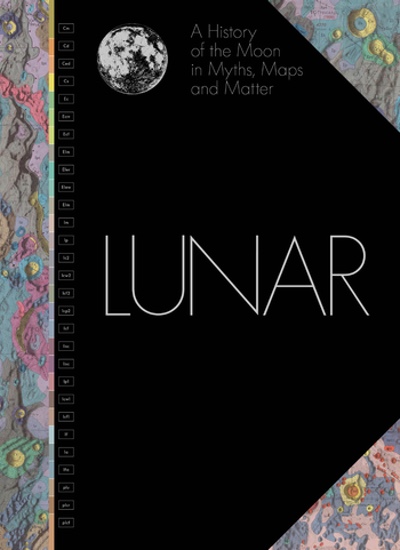Review: Lunar: A History of the Moon in Myths, Maps, and Matterby Christopher Cokinos
|
| Lunar seeks a more sweeping and balanced approach, where one will be surprised by the essays and their turns among science and the humanities. |
Edited by National Air and Space Museum curator Matthew Shindell, Lunar is an exquisitely designed and gorgeously produced coffee table book using the famed US Geological Survey rock-type Moon maps as an organizing motif. These colorful maps form the basis of the book’s atlas sections, but there is so much more: Apollo landing photographs and facts, photos and brief descriptions of lunar features, and essays on everything from “The Moon in Silent Cinema” to “The Moon in Literature and Fiction.” While not a comprehensive history or encyclopedia, Lunar is beautiful and rangy. It covers the arts, history and science within its visually compelling pages.
Lunar, whether consciously or not, harkens back to the Apollo-era coffee table book Moon: Man’s Greatest Adventure. A brief comparative reading is interesting.
Moon: Man’s Greatest Adventure featured Wernher von Braun describing why the missions were the first step toward human immortality—a worthwhile essay even if you don’t agree with him. The book opens with a long, profusely illustrated overview by Silvio A. Bedini called “Man and the Moon,” which surveys folklore, art, lunar life, timekeeping, and more. The rest of Moon is Space-Age and Apollo-centric. (Long out-of-print, this book still belongs on the shelves of space enthusiasts.)
Lunar seeks a more sweeping and balanced approach, where one will be surprised by the essays and their turns among science and the humanities. It’s book that seeks to bridge the “two-culture” divide that C.P. Snow described years ago and that still abides.
There are engaging, sober, and well-researched pieces on the full Moon and madness, astrology, Galileo and some other pioneering telescopists of the Moon, and literature and the arts, among other topics. The essay on 19th century lunar painting captures a good deal of history in a short space, even noting that the Moon-obsessed Ralph Blakelock became so popular that forgeries of his work, called “Fakelocks,” are themselves “now in high demand on the art market.” An essay on “The Feminine Symbolism of the Moon” will introduce readers to contemporary artists, while the next piece, “The Moon in Popular Science Books,” takes on a literature not often considered. We learn everything from tides to phases. Early philosophical attempts to understand the Moon get their due.
| An essay on “The Feminine Symbolism of the Moon” will introduce readers to contemporary artists, while the next piece, “The Moon in Popular Science Books,” takes on a literature not often considered. |
The illustrations throughout are stunning. Consider those with “Lunar Photography—Opportunity and Challenge.” This terrific entry introduces readers to the history of lunar photography—which, early on, was fraught with difficulty—and is supplemented by 18 vivid illustrations. The most compelling are those from James Nasmyth (whose story is told elsewhere in the book). Nasmyth and James Carpenter’s 1874 book on The Moon: Considered as a Planet, a World, and a Satellite was enormously influential in proposing volcanic processes as the driving force of the lunar surface. Now the book is best known for photographs they took of plaster-of-Paris models of the Moon’s features, which themselves were based on assiduous observing and drawings. An eye-popping two-page spread of those photographs gives readers giant mountains and hyper-sharp craters.
More esoteric but also appealing are illustrations of now-forgotten paper moon photos and cards. We get silent films, surrealists, and marketing—the last of which, featuring Wernher von Braun, Willy Ley, and Chesley Bonestell, will be familiar to space enthusiasts. Welcome histories of the race between early uncrewed probes from the US and the USSR highlight this oft-overlooked material. Posters of sci-fi Moon movies may give you tips for weekend viewing or something to buy on eBay.
My reservations are few. I wish the book had larger photos of lunar features. The essay portions of the book could have used additional subject coverage, such as transient lunar phenomena, 19th century selenographers (a fascinating bunch) ,and visions of sustainable lunar living. The Moon’s role in poetry is strangely absent. Essays cover Mayan, Greek, Roman, Lakota, and Egyptian views of the Moon, but one of the most lunar-centric cultures, China, is not included.
Within individual essays, there are some gaps or misstatements. Alexander Marshack argued in the 1970s that ancient lunar timekeeping was not only a start of a scientific approach to nature but was, in fact, the beginning of human self-consciousness. A fascinating history of the Moon’s perceived role in sexual intercourse, birth, and menstruation leaves out the fact the there is no scientific evidence linking the Moon’s phases with menstruation; the 28-day cycles are a coincidence. George Darwin’s work on tides is left unmentioned, which might have led to a discussion of the Moon’s origins.
Lunar is still a quite-worthy addition to contemporary offerings about the Moon and is unquestionably a visual treat. Space enthusiasts, ordinary readers and policymakers should spend time with its pages.
Note: we are now moderating comments. There will be a delay in posting comments and no guarantee that all submitted comments will be posted.
